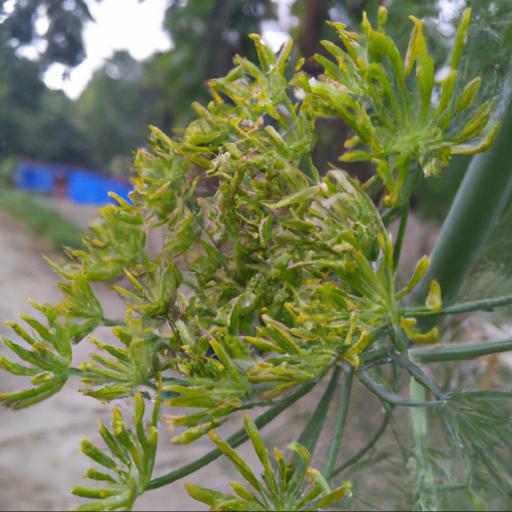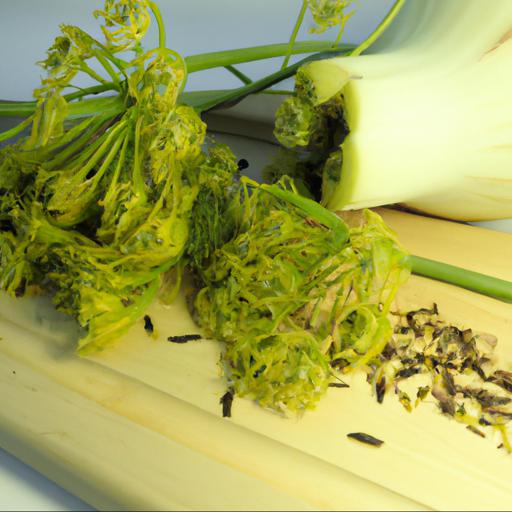Foeniculum vulgare purpureum, commonly known as purple fennel, is a species of flowering plant in the carrot family. Native to the Mediterranean region, it is used as a culinary herb and is known for its anise-like flavor.
It has a long history of use in traditional medicine, and is believed to have many health benefits. In this blog, we’ll discuss the nutritional content of purple fennel, its potential health benefits, and how to incorporate it into your diet. We’ll also look at some of the possible side effects and precautions to consider.
Health benefits of foeniculum vulgare purpureum

Foeniculum vulgare purpureum or commonly known as sweet fennel or bronze fennel is a flowering plant, native to the Mediterranean region and is renowned for its wide range of medicinal properties and culinary uses. The herb is widely used as an organic remedy for a variety of issues ranging from digestive discomfort to respiratory and circulatory problems, as well as its use in alcoholic beverages and desserts.
What makes sweet fennel so appealing and medically desirable is the presence of powerful compounds like flavonoids and compounds like coumarin and anethole, which are proven to affect human hormone levels, reduce inflammation, relax body muscles and significantly reduce pain levels. When it comes to health benefits, sweet fennel has been proven to be effective in addressing a wide range of ailments and conditions. For instance, it has been used traditionally to treat digestive disorders such as indigestion and diarrhea but also to regulate blood sugar levels, enhance digestion and stimulate the production of bile and gastric acid.
As a natural source of electrolytes it also helps maintain fluid balance in the body, while its anti-inflammatory effects can help to reduce inflammation and reduce chronic pain. The herb has also been used successfully to treat upper respiratory conditions such as asthma or congestion, and its antispasmodic properties are believed to reduce coughs and bronchitis.
Moreover, sweet fennel has antiseptic qualities and can be applied topically to tackle wounds or ulcers. Furthermore, its antioxidative properties can help to protect against oxidative stress, potentially reducing the risk of some cancerous diseases. In conclusion, sweet fennel offers numerous health benefits due to its potent anti-inflammatory, antispasmodic and antioxidant properties.
This versatile herb can be consumed as a tea, added to your favourite dishes as a condiment, or used topically. Regardless of the method, it is clear that sweet fennel is an important source of natural remedies and should definitely be a part of your everyday diet.
How to grow foeniculum vulgare purpureum

Foeniculum vulgare purpureum, also known as bronze fennel, is a popular perennial herb with a long history of cultivation for its aromatic leaves and seeds. With its feathery green foliage and clusters of tall flowers, it makes a striking addition to any garden.
While it is easy to grow, there are some basic steps that should be followed to ensure a successful harvest. To begin, you will need to find a spot in your garden that gets full sun for at least six hours a day. Fennel prefers loose, well-drained soil with a pH level of
5- You can add compost or manure to the soil before planting to improve the fertility of the soil if needed.
Plant seeds directly in the garden in early spring, spacing them at least 6 inches apart. Water the soil thoroughly to settle the seeds and keep the soil moist.
Once the fennel has grown to a height of 6-8 inches, it’s time to begin harvesting. The leaves and seeds can both be used fresh or dried for later. Harvest the leaves before the flowers bloom, as their flavor is at its peak at this time.
To harvest the seeds, let the flower heads mature and turn brown. When the seedpods are dry and fall off easily, they are ready to collect.
Be sure to separate the seeds from the husk before storing. Foeniculum vulgare purpureum can be a great addition to any garden. With proper care and a bit of patience, you’ll be able to harvest a plentiful crop of leaves, stems and seeds to use in a variety of recipes. So why not give it a try this season and get creative in the kitchen?
Culinary uses of foeniculum vulgare purpureum

Foeniculum Vulgare Purpureum, otherwise known as purple fennel, is a staple of the modern kitchen but it has been employed in cooking for centuries. It is a relative of the common fennel, but has a darker coloration, a milder flavor, and a softer texture than its counterpart. This makes purple fennel an excellent ingredient for a variety of dishes, including salads, stews, curries, and pastas.
Purple fennel has a distinct anise-like scent and sweeter taste compared to traditional fennel, which can be attributed to the compound anethole in the seeds. It has an added flavor advantage that many find attractive – the ability to remain distinct even after cooking.
This means that you can use it in a soup or stew, but still get the full flavor of the fennel when added into the dish. The large bulb on the top of purple fennel is the most versatile part of the plant.
It can be served raw, cooked and even roasted. When eaten raw, the bulb adds a nice crunch that and is perfect for salads and slaws. When cooked, it offers a sweet flavor and a delicate texture – great for adding to soups and even risotto.
Roasting adds intense flavor and a memorable aroma, making this herb a great choice for serving alongside proteins. Whether you’re adding a touch of flavor to a soup or using it as the star of a salad, purple fennel is an incredibly versatile ingredient and an excellent choice for adding something special to your dishes. With its flavorful, aromatic notes and endless applications, it’s no wonder purple fennel is quickly becoming a kitchen favorite.
Interesting facts about foeniculum vulgare purpureum
:Foeniculum vulgare purpureum, more commonly known as bronze fennel, is a stunning and versatile herb that has been used throughout history in a variety of ways. Being a part of the umbellifereae family of plants, bronze fennel is related to other popular herbs like parsley, cumin and those of the carrot family such as parsnips and caraway. Bronze fennel, in particular, is unique in that it has dark purple and bronze foliage in addition to its yellow flowers, making it a dramatically beautiful plant.
This beautiful herb is native to Southern Europe and Asia Minor and it has since been naturalized in many parts of the United States. The foliage of this herb is often used in salads, sauces and even as a garnish.
The fragrant leaves are also often used to add flavor to foods. The seeds of this herb are also quite popular in cooking and are often used to flavor meats, teas, breads and curries.
The essential oil extracted from bronze fennel is also used medicinally for its antispasmodic, anti-inflammatory and stomach soothing properties. Still, it is advised that you consult a doctor before using bronze fennel medicinally as it can interact with some therapies. Foeniculum vulgare purpureum is an incredibly versatile and useful gardening and health aid that has been relied upon through the ages.
Its distinct purple and bronze foliage is a stunning addition to the garden, while its tasty leaves and seeds can be used to add flavor to a variety of dishes and its essential oils can be used medicinally. With all these uses, it’s no wonder why bronze fennel continues to be a popular herb.
Our video recommendation
Final Touch
Foeniculum vulgare purpureum, commonly known as bronze fennel, is an aromatic herb with a sweet anise-like flavor. It is used in many culinary dishes, teas, and medicines.
The leaves, stems, and flowers of the plant are edible and can be used fresh or dried. Bronze fennel is a great addition to salads, soups, and sauces. It also has many medicinal properties and can be used to treat a variety of ailments, such as indigestion, respiratory issues, and skin conditions.
Bronze fennel is easy to grow and can be found in many gardens.
FAQ
What are the benefits of Foeniculum vulgare purpureum?
The benefits of Foeniculum vulgare purpureum include its ability to reduce inflammation, improve digestion, and act as a natural diuretic. It is also known to have antioxidant and antimicrobial properties, which can help protect against certain diseases. Additionally, it can be used to treat respiratory issues, such as colds and coughs, and can help reduce stress and anxiety.
What is the scientific name of Foeniculum vulgare purpureum?
The scientific name of Foeniculum vulgare purpureum is Foeniculum vulgare ‘Purpureum’.
How is Foeniculum vulgare purpureum used in cooking?
Foeniculum vulgare purpureum, commonly known as bronze fennel, is used in cooking as an herb, spice, and vegetable. It has a sweet, anise-like flavor and can be used in salads, soups, stews, and sauces. It can also be used to flavor fish, poultry, and pork dishes.
What are the medicinal properties of Foeniculum vulgare purpureum?
Foeniculum vulgare purpureum, commonly known as purple fennel, has many medicinal properties. It is known to have anti-inflammatory, antispasmodic, diuretic, and expectorant properties. It is also used to treat digestive problems, such as indigestion, bloating, and flatulence. It is also used to treat respiratory problems, such as coughs, bronchitis, and asthma. Additionally, it is known to have anti-bacterial and anti-fungal properties, making it useful for treating skin conditions such as eczema and psoriasis.
How is Foeniculum vulgare purpureum grown?
Foeniculum vulgare purpureum is typically grown from seed, either directly in the garden or in a pot. It prefers full sun and well-drained soil. It can also be propagated through division in the spring.
What are the nutritional benefits of Foeniculum vulgare purpureum?
Foeniculum vulgare purpureum, also known as purple fennel, is a nutritious vegetable that is high in dietary fiber, antioxidants, and essential vitamins and minerals. It is a good source of vitamin C, folate, potassium, and manganese, as well as dietary fiber. It also contains phytonutrients that may help reduce inflammation and protect against certain diseases. Additionally, purple fennel is low in calories and fat, making it a healthy addition to any diet.

